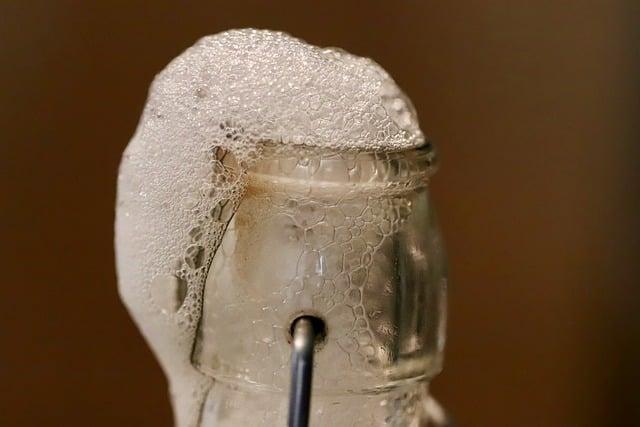In the world of probiotic wonders, one peculiar yet fascinating creature reigns supreme – the kombucha SCOBY. A mysterious symbiotic culture of bacteria and yeast, this jellyfish-like entity holds the key to fermenting that tangy, effervescent elixir known as kombucha. Join us on a journey to unravel the secrets of this ancient brewing marvel and discover how it transforms simple tea into a fizzy, health-boosting powerhouse.
Table of Contents
- Understanding the Role of a Kombucha SCOBY in Fermentation
- Top Tips for Caring for Your Kombucha SCOBY to Ensure Healthy Brews
- Exploring Creative Ways to Use Your Kombucha SCOBY Beyond Brewing
- The Science Behind the Symbiotic Culture of Bacteria and Yeast (SCOBY) in Kombucha
- Q&A
- The Way Forward
Understanding the Role of a Kombucha SCOBY in Fermentation
The symbiotic culture of bacteria and yeast, commonly known as SCOBY, is the heart of kombucha fermentation. This rubbery, pancake-like colony plays a crucial role in transforming sweet tea into the tangy, fizzy drink we all love. Within the distinct layers of the SCOBY reside various strains of beneficial bacteria and yeast, each contributing to the fermentation process in its unique way.The SCOBY acts as a living home for microorganisms, providing them with the ideal environment to thrive and carry out the fermentation process. Through a symbiotic relationship, the bacteria and yeast work in harmony to convert the sugars in the tea into organic acids and carbon dioxide, giving kombucha its signature tangy flavor and effervescence. Understanding the intricate dance of microbiology within the SCOBY is key to mastering the art of brewing delicious and probiotic-rich kombucha at home.

Top Tips for Caring for Your Kombucha SCOBY to Ensure Healthy Brews
Taking care of your Kombucha SCOBY is essential to brewing delicious and healthy kombucha at home. Here are some top tips to help you nurture your SCOBY and ensure that your brews turn out just right:Firstly, make sure to **keep your SCOBY clean**. Regularly rinse it with distilled white vinegar or plain water to prevent mold growth. Avoid using soap or harsh chemicals, as they can harm the SCOBY.
<p>**Maintain the proper temperature** for your SCOBY. It thrives best in a warm environment, ideally between 75-85°F. Extreme temperatures can stress the SCOBY, affecting the fermentation process and the quality of your kombucha.</p>In addition, use quality ingredients when brewing your kombucha. Opt for organic tea and sugar to provide the best nutrition for your SCOBY. Remember, a happy and healthy SCOBY leads to tangy and tasty kombucha. Lastly, be patient. Fermentation takes time, so allow your SCOBY the necessary days to work its magic and transform your tea into a fizzy, probiotic-rich beverage. By following these tips, you’ll be well on your way to brewing top-notch kombucha that you can enjoy and share with friends and family.

Exploring Creative Ways to Use Your Kombucha SCOBY Beyond Brewing
Sure, here is the content for the post section:Looking to elevate your Kombucha SCOBY game? Take a plunge into the world of innovative possibilities beyond the traditional brewing process. Embrace the versatility of your SCOBY with these unconventional and creative ideas:
- Kombucha SCOBY Face Mask: Treat your skin to a nourishing and rejuvenating experience by using your SCOBY as a natural face mask. Rich in probiotics and enzymes, it can help restore your skin’s glow and vitality.
- SCOBY Jerky: Transform your SCOBY into a savory snack by dehydrating and marinating it to create a unique jerky texture. Packed with flavor and a hint of tanginess, it’s a healthy alternative for your munching cravings.
- SCOBY Art: Unleash your creativity by incorporating your SCOBY into art projects. Its rubbery texture and intricate patterns make it a fascinating medium for creating organic and eco-friendly artworks.
| Recipe | Ingredients |
| SCOBY Fruit Leather | SCOBY, fruit puree, honey |
| SCOBY Dog Treats | SCOBY, peanut butter, oats |


The Science Behind the Symbiotic Culture of Bacteria and Yeast (SCOBY) in Kombucha
In the fascinating world of Kombucha brewing, the symbiotic culture of bacteria and yeast (SCOBY) plays a pivotal role in transforming simple ingredients into a tangy, effervescent elixir. This living, gelatinous disc might seem like an otherworldly creation, but its science is firmly grounded in the principles of fermentation. Here’s a closer look at the intricate dance of microorganisms that gives Kombucha its unique character.When you delve into the microscopic realm of a SCOBY, you’ll discover a bustling community of beneficial bacteria and yeast working harmoniously to ferment sweet tea into Kombucha. The bacteria, primarily Acetobacter xylinum, contribute to the formation of cellulose that gives the SCOBY its structure, while yeast species like Saccharomyces cerevisiae and Brettanomyces bruxellensis break down sugars into alcohol and organic acids. This dynamic interplay results in a complex flavor profile and the signature slight fizziness that Kombucha enthusiasts adore.
Q&A
Q: What is a kombucha scoby, and why is it essential for making kombucha?A: A kombucha scoby, short for “symbiotic culture of bacteria and yeast,” is the magical ingredient that turns sweet tea into tangy, effervescent kombucha. It resembles a rubbery pancake and plays a crucial role in the fermentation process by consuming the sugars in the tea and converting them into beneficial acids and probiotics.
Q: How do you take care of a kombucha scoby?
A: Caring for your kombucha scoby is as simple as brewing a cup of tea! Keep it in a glass jar with a bit of brewed kombucha, cover it with a cloth to allow airflow, and store it in a warm, dark place away from direct sunlight. Remember to feed it with fresh tea and sugar regularly to keep it happy and healthy.
Q: Can you reuse a kombucha scoby?
A: Absolutely! A kombucha scoby is a generous friend that keeps on giving. After each batch of kombucha, your scoby will grow a new layer, which can be used to start a new batch or shared with fellow brewers. With proper care, a single scoby can last for many brews, spreading kombucha love far and wide.
Q: What are some common signs that indicate my kombucha scoby is unhealthy?
A: While kombucha scobys are resilient beings, they can sometimes show signs of distress. Look out for mold, unusual colors, off-putting odors, or excessive sliminess, which could indicate that something is amiss. In such cases, it’s best to retire your scoby and start fresh to ensure the quality and safety of your kombucha.
Q: Besides brewing kombucha, are there any other creative ways to use a kombucha scoby?
A: Indeed, there are! Kombucha scobys are versatile creatures that can be used in various DIY projects. From making tasty fruit leather to crafting skin-loving facial masks, exploring the possibilities with your scoby can add a fun and eco-friendly twist to your kombucha brewing journey.
